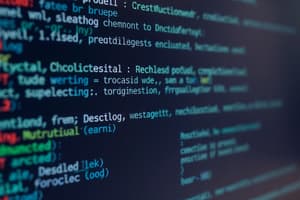Podcast
Questions and Answers
What is the purpose of encoding messages before sending them over a network?
What is the purpose of encoding messages before sending them over a network?
- To convert them into bits (correct)
- To change the destination address
- To increase the message size
- To ensure security
Encapsulation refers to the process of sending data without any addressing information.
Encapsulation refers to the process of sending data without any addressing information.
False (B)
Which of the following is NOT a common networking protocol?
Which of the following is NOT a common networking protocol?
- Transmission Control Protocol (TCP)
- Hypertext Transfer Protocol (HTTP)
- File Transfer Protocol (FTP) (correct)
- Internet Protocol (IP)
What is the function of a frame in network communication?
What is the function of a frame in network communication?
The Internet Protocol (IP) manages individual conversations between devices.
The Internet Protocol (IP) manages individual conversations between devices.
The process of breaking long messages into smaller parts for transmission is known as ______.
The process of breaking long messages into smaller parts for transmission is known as ______.
Which type of message delivery is best described as one-to-many?
Which type of message delivery is best described as one-to-many?
What does the HTTP protocol primarily govern?
What does the HTTP protocol primarily govern?
The _____ protocol is responsible for encapsulating TCP segments into packets.
The _____ protocol is responsible for encapsulating TCP segments into packets.
Match the message delivery options with their descriptions:
Match the message delivery options with their descriptions:
Hosts on a network need to know how to handle response timeouts.
Hosts on a network need to know how to handle response timeouts.
Match the protocols to their respective layers:
Match the protocols to their respective layers:
Each frame in a network has its own ______ information.
Each frame in a network has its own ______ information.
During the TCP/IP communication process, which layer adds source and destination addresses?
During the TCP/IP communication process, which layer adds source and destination addresses?
The Ethernet protocol deals with the physical transmission of data on the network media.
The Ethernet protocol deals with the physical transmission of data on the network media.
What is the main purpose of networking protocols?
What is the main purpose of networking protocols?
What is the correct order in which the protocol headers are removed by the client when receiving data from a web server?
What is the correct order in which the protocol headers are removed by the client when receiving data from a web server?
Open standards discourage interoperability among different vendors.
Open standards discourage interoperability among different vendors.
What organization is responsible for coordinating IP address allocation?
What organization is responsible for coordinating IP address allocation?
The _____ is focused on long-term research related to Internet and TCP/IP protocols.
The _____ is focused on long-term research related to Internet and TCP/IP protocols.
Match the following organizations with their functions:
Match the following organizations with their functions:
Which of the following organizations is dedicated to standardizing electrical wiring?
Which of the following organizations is dedicated to standardizing electrical wiring?
The Internet Architecture Board (IAB) is responsible for managing domain name allocations.
The Internet Architecture Board (IAB) is responsible for managing domain name allocations.
What type of organization are standards organizations typically described as?
What type of organization are standards organizations typically described as?
What is one benefit of using a layered model in networking?
What is one benefit of using a layered model in networking?
The TCP/IP model was created in the early 1980s.
The TCP/IP model was created in the early 1980s.
Name the layer of the OSI model that is responsible for data segmentation and transfer.
Name the layer of the OSI model that is responsible for data segmentation and transfer.
The __________ layer of the OSI model provides methods for exchanging data frames.
The __________ layer of the OSI model provides methods for exchanging data frames.
Which OSI model layer is primarily responsible for end-to-end communications?
Which OSI model layer is primarily responsible for end-to-end communications?
Match the following layers to their primary functions:
Match the following layers to their primary functions:
The OSI model is a less detailed version of the TCP/IP protocol model.
The OSI model is a less detailed version of the TCP/IP protocol model.
The layer in the TCP/IP model that corresponds to the OSI's application layer is known as the __________ layer.
The layer in the TCP/IP model that corresponds to the OSI's application layer is known as the __________ layer.
What part of an IP address indicates which network the address belongs to?
What part of an IP address indicates which network the address belongs to?
A data link frame can be sent directly to a remote destination host.
A data link frame can be sent directly to a remote destination host.
What is the function of the default gateway in a network?
What is the function of the default gateway in a network?
The ______ address identifies a specific device on a network.
The ______ address identifies a specific device on a network.
Match the following terms with their definitions:
Match the following terms with their definitions:
Flashcards are hidden until you start studying
Study Notes
Message Encoding
- Messages are converted into bits by the sending host.
- Each bit is encoded into patterns of sounds, light waves, or electrical impulses depending on the network media.
- Destination host receives and decodes the signals to interpret the message.
Message Formatting and Encapsulation
- Messages are formatted for letters and addressing letters, which is required for proper delivery.
- Encapsulation is putting the letter into the addressed envelope.
- Each computer message is encapsulated in a specific format, called a frame, before being sent over the network.
- A frame acts as an envelope, and includes a destination address and source address.
Message Size
- Humans break long messages into smaller parts or sentences.
- Long messages are broken into smaller pieces in order to travel across a network.
- Each piece is sent in a separate frame with its own addressing information.
- A receiving host will reconstruct multiple frames into the original message.
Message Timing
- Hosts on a network need to know when to begin sending messages and how to respond when collisions occur, this is called access method.
- Flow control is used by source and destination hosts to negotiate correct timing, to avoid overwhelming the destination and to ensure information is received.
- Hosts on the network have rules that specify how long to wait for responses and what action to take if a response timeout occurs.
Message Delivery Options
- Unicast Message: One-to-one delivery
- Multicast Message: One-to-many delivery
- Broadcast Message: One-to-all delivery
Protocols
- Protocol suites are implemented by hosts and networking devices in software, hardware or both.
- Protocols are viewed in terms of layers, with each higher level service depending on the functionality defined by the protocols in the lower levels.
Network Protocols
- Networking protocols define a common format and set of rules for exchanging messages between devices
- Common networking protocols include Hypertext Transfer Protocol (HTTP), Transmission Control Protocol (TCP), and Internet Protocol (IP).
Protocol Interaction
- Communication between a web server and web client is an example of an interaction between several protocols:
- HTTP - an application protocol governing the way a web server and a web client interact.
- TCP - transport protocol that manages the individual conversations.
- IP – encapsulates the TCP segments into packets, assigns addresses, and delivers to the destination host.
- Ethernet - allows communication over a data link and the physical transmission of data on the network media.
TCP/IP Protocol Suite
- TCP/IP communication process:
- The webserver prepares the Hypertext Markup Language (HTML) page.
- The HTTP application layer protocol sends the data to the transport layer.
- The transport layer breaks the data into segments and identifies each.
- Next the IP source and destination addresses are added, creating an IP Packet.
- The Ethernet information is then added creating the Ethernet Frame, or data link frame.
- This frame is delivered to the nearest router along the path towards the web client.
- Each router adds new data link information before forwarding the packet.
TCP/IP Communication Process (Cont.)
- Receiving data link frames from the web server:
- The client processes and removes each protocol header in the opposite order it was added.
- The Ethernet header is removed first.
- The IP header is removed next.
- The Transport layer header is removed next.
- Finally the HTTP information is processed and sent to the client's web browser.
Open Standards
- Open standards encourage interoperability, competition, and innovation.
- Standards organizations are usually vendor-neutral, non-profit organizations established to develop and promote the concept of open standards.
Internet Standards
- Internet Society (ISOC) - promotes open development and evolution of Internet use globally.
- Internet Corporation for Assigned Names and Numbers (ICANN) - coordinates IP address allocation and management of domain names.
- Internet Architecture Board (IAB) - management and development of Internet standards.
- Internet Assigned Numbers Authority (IANA) - manages IP address allocation, domain name management, and protocol identifiers for ICANN.
- Internet Engineering Task Force (IETF) - develops, updates, and maintains Internet and TCP/IP technologies.
- Internet Research Task Force (IRTF) - focused on long-term research related to Internet and TCP/IP protocols.
Electronics and Communications Standard Organizations
- Institute of Electrical and Electronics Engineers (IEEE) - dedicated to advancing technological innovation and creating standards in a wide area of industries including networking.
- Electronic Industries Alliance (EIA) - standards related to electrical wiring, connectors, and network racks.
- Telecommunications Industry Association (TIA) standards for radio equipment, cellular towers, Voice over IP (VoIP) devices, and satellite communications.
- International Telecommunications Union- Telecommunication Standardization Sector (ITU-T) standards for video compression, Internet Protocol Television (IPTV), and broadband communications.
The Benefits of Using a Layered Model
- Assisting in protocol design, since protocols at each layer have defined functions.
- Fostering competition because products from different vendors can work together.
- Preventing technology changes in one layer from affecting other layers.
- Providing a common language to describe networking functions and capabilities.
The OSI Reference Model
- Application: contains protocols used for process-to-process communications.
- Presentation: provides for common representation of the data.
- Session: provides services to the presentation layer to organize its dialogue and to manage data exchange.
- Transport: defines services to segment, transfer, and reassemble the data.
- Network: provides services to exchange the individual pieces of data over the network between identified end devices.
- Data Link: provides methods for exchanging data frames between devices over a common media.
- Physical: describes the mechanical, electrical, functional, and procedural means to transmit bits across physical connections.
The TCP/IP Protocol Model
- Created in the early 1970s for internetwork communications
- Open standard.
- Also called The TCP/IP Model or the Internet Model.
OSI Model and TCP/IP Model Comparison
- In the OSI model, the network access layer and the application layer of the TCP/IP model are further divided to describe discrete functions that must occur at these layers.
Data Access
- Devices on the Same Network:
- The network layer addresses, or IP addresses, indicate the original source and final destination.
- The left-most part of the address indicates which network the IP address is a member of, this is known as the network portion.
- The remaining part of the address identifies a specific device on the network, this is known as the host portion.
- The data link frame which uses MAC addressing, is directly sent to the receiving device.
- The source MAC address is the address of the sending device.
- The destination MAC address is the address of the receiving device.
Data Access
- Devices on a Remote Network:
- Sending to a remote network - the source and destination IP addresses represent hosts on different networks.
- The data link frame cannot be sent directly to the remote destination host.
- This frame is sent to the default gateway (nearest router interface) and the router removes the received Layer 2 information and adds new data link information before forwarding out the exit interface.
Conclusion
- Explains how rules facilitate communication.
- Explains the role of protocols and standards organizations in facilitating interoperability in network communications.
- Explains how devices on a LAN access resources in a small to medium sized business network.
Studying That Suits You
Use AI to generate personalized quizzes and flashcards to suit your learning preferences.




